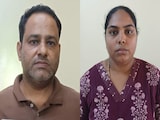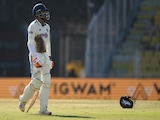- The 2008 Mumbai attacks involved 12 coordinated strikes by Lashkar-e-Taiba terrorists.
- At least 166 people died and over 300 were injured during the 60-hour siege.
- Attack locations included the Taj Mahal hotel, Chhatrapati Shivaji Terminus, and Oberoi Trident.
It's been 17 years, but the scars of the Mumbai terror attacks are still fresh. On November 26, 2008, a series of 12 coordinated attacks in Mumbai shook the world. The attacks, carried out by 10 members of the Pakistan-based Lashkar-e-Taiba (LeT), resulted in the deaths of at least 166 people, including civilians, security personnel, and nine attackers. More than 300 people were injured. The lone surviving attacker, Mohammed Ajmal Amir Qasab from Pakistan, was arrested. He was handed the death penalty in 2010 and executed two years later.
The attacks, which lasted for 60 hours, were one of the deadliest terrorist attacks in Indian history, targeting prominent locations such as the Chhatrapati Shivaji Terminus, the Oberoi Trident, the Taj Mahal Palace and Tower hotel, the Leopold Cafe and the Nariman House.
This image shows a reporter talking on her phone as smoke is seen coming from the Taj Hotel in Mumbai, November 27, 2008.
Photo Credit: AFP
Fire engulfs the top floor of the Taj Mahal hotel on November 26, 2008.
Photo Credit: AFP
Employees and guests of the Taj Mahal hotel are being rescued by firefighters after fire engulfed the top floor of the hotel.
Photo Credit: AFP
Explosions and gunfire continued intermittently at the Taj Mahal hotel even two days after a chain of attacks across Mumbai.
Photo Credit: AFP
This image shows the windows on the first floor of the Taj Mahal hotel being shattered after the use of a grenade launcher on November 28.
Photo Credit: AFP
The images are juxtaposed to show the before and after of the Taj Mahal Palace.
The attack on the Taj Mahal hotel, a symbol of opulence, was like attacking the heart of the city. What remained an iconic spot turned into a building of death and horror, with blood and corpses scattered everywhere.
Not just the Taj Mahal hotel, the choices of buildings attacked by the terrorists were not random; the spots were basically centres of the city's economic and social life, and attacking these spots was like wounding the financial capital of India, both literally and symbolically.
Here's A Timeline Of How The Attacks Were Carried Out
The terrorists, armed with AK-47 rifles, RDX, and grenades, arrived in Mumbai via the sea route from Pakistan and split into smaller groups to carry out the attacks.
November 23, 2008
The terrorists leave Karachi by boat and seize a fishing trawler near the Indian coastline. They kill four crew members and force the remaining to steer the vessel towards Mumbai. After reaching near the city, they kill the captain as well. They then use inflatable boats to cover the 7 km offshore. Out of ten, six land at Cuffe Parade's Macchimar Nagar, and the rest get off near Badhwar Park.
November 26, 2008
9:20 PM: The first attack occurr at the Chhatrapati Shivaji Terminus, killing 58 people and injuring 104. Two terrorists, Kasab and Ismail Khan, fire into crowds. They are pictured here, with horrific photos commonly known as "backpackers with assault rifles".
This picture shows the aftermath of the Chatrapathi Sivaji Terminal railway station.
Photo Credit: AFP
CCTV cameras captured the terrorist.
Photo Credit: AFP
9:30 PM: The terrorists carry out an explosion to draw attention to the Nariman (Chabad) House, housing the Jewish Chabad Lubavitch outreach centre. They open fire from the windows. Several hostages, including the rabbi and his wife, are killed. Meanwhile, their two-year-old child survives.
Image from the Nariman House.
Photo Credit: AFP
This image shows how NSG commandos came down a rope, from a helicopter to reach the top of the Nariman house.
Photo Credit: AFP
9:30-9:48 PM: Almost at the same time, the Leopold Cafe was attacked, where terrorists kill 10 people.
9:35-9:45 PM: The Taj Mahal Palace and Tower hotel is attacked, with at least six explosions reported. Two terrorists, Shoib and Umer, who attacked the Leopold Cafe, enter the hotel by breaking down a side door. Two other terrorists, Abdul Rehman Bada and Abu Ali, enter the hotel through the front entrance and start to shoot and throw grenades. Marine commandos enter the hotel and confront them.
10:00 PM: The Oberoi Trident hotel is attacked, with two terrorists holding hostages.
This picture shows a hostage looking out from a window of the hotel.
Photo Credit: AFP
10:30 PM: Kasab and Khan, who struck CST first, arrive at the back gate to the Cama Hospital. One staff member alerted others and lock all of the patients' rooms. They leave the hospital and ambush a group of police officers, killing six of them, including the chief of the city's Anti-Terrorism Squad, Hemant Karkare. After that, they hijack a police vehicle before being intercepted by a team from the Gamdevi police station. Khan is killed, and Kasab is arrested.
On November 26, 2008, a taxi blast rocked Ville Parle leaving three dead.
Photo Credit: AFP
November 27, 2008
6:30 AM: National Security Guards (NSG) assume control of counter-terror operations, and evacuations continue throughout the day at both hotels.
November 28, 2008
Commandos carry out a rooftop entry at Nariman House. They also rescue many hostages from the Oberoi Trident hotel. Terrorists at Nariman House are eliminated by evening. The Oberoi siege ends the same afternoon, with around 30 people reported dead.
November 29, 2008
The Indian security forces, including the National Security Guards (NSG), launched a final operation to flush out the remaining terrorists, ending the siege at the Taj Hotel.
The Heroes of 26/11
The 2008 Mumbai attacks saw the bravery of security personnel, including Major Sandeep Unnikrishnan, Hemant Karkare, and Tukaram Omble, who lost their lives in the line of duty.
Investigation
The attacks led to widespread condemnation and a strong response from the Indian government. The investigation revealed that the Lashkar-e-Taiba, a Pakistan-based terrorist organisation, was responsible for the attacks.















